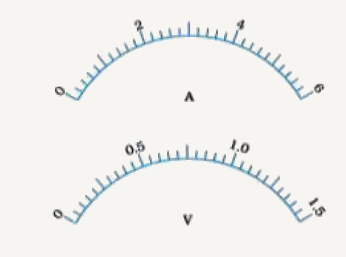What is an ammeter ? Solution in Punjabi
Ammeter : It is a low resistance instrument used to measure electric current in a circuit. An ideal ammeter should have zero resistance. It is always connected in series in an electrical circuit.
Conversion of galvanometer into an ammeter : Consider a galvanometer of resistance G. It can be converted into an ammeter by connecting a low resistance called shunt (S) in series with it.
The value of shunt depends upon the range of current to be measured.
Suppose we want to convert a galvanometer into an ammeter of range0−Iampere.
Ig= Maximum current that can pass through the galvanometer.
n = Number of divisions in the galvanometer scale
k = Figure of merit (or current for deflection of the one division in the galvanometer)
∴Ig=nk
the value of S is so adjusted that out of maximum current I, only a part Ig should flow through the galvanometer and the remaining (I−Ig) flows through the shunt.
As G and S are connected in parallel with each other, so
So VA−VB=IgG=(I−Ig)S
S=(IgI−Ig)G
Thus, s can be determined.
So by connecting shunt resistance of suitable value in series with a galvanometer, we can get an ammeter of range 0−I ampere.
Voltmeter : It is a high resistance instrument which is used to measure potential difference across the two points in a circuit.
Resistance of an ideal voltmeter is infinite.
Voltmeter is always connected in parallel in an electrical circuit.
Conversion of galvanometer into a voltmeter : Consider a galvanometer of resistance G.We want to convert it into a voltmeter of range 0 to V volt.

It can be done by connecting a high resistance R in parallel withe the galvanometer.
The value of R depends upon the range of voltage to be measured.
Let Ig= Current that gives full scale deflection in galvanometer.
n = Number of divisions in the galvanometer scale
k = Figure of merit
∴Ig=nk.
The value of R is connected in series with the galvanometer so that a current Igflows through the galvanometer when a potential difference V is applied across the points A and B.
As G and R are connected in series, so
V=Ig(G+R) (By Ohm.s law)
G+R=VIg
If a resistance of the value given by above eqn. is connected in series with the galvanometer, it will work as a voltmeter of the range (0−V) volt.

Topper's Solved these Questions
- BOOK - BETTER CHOICE PUBLICATIONCHAPTER - FORCE ON A CURRENTEXERCISE - SHORT ANSWER TYPE QUESTIONS (MOST EXPECTED QUESTIONS)5videos
FORCE ON A CURRENT
- BOOK - BETTER CHOICE PUBLICATIONCHAPTER - FORCE ON A CURRENTEXERCISE - LONG ANSWER TYPE QUESTIONS15videos
FORCE ON A CURRENT
- BOOK - BETTER CHOICE PUBLICATIONCHAPTER - FORCE ON A CURRENTEXERCISE - VERY SHORT ANSWER TYPE QUESTIONS (MOST EXPECTED QUESTIONS )5videos
FORCE ON A CURRENT
- BOOK - BETTER CHOICE PUBLICATIONCHAPTER - FORCE ON A CHARGE EXERCISE - NUMERICAL PROBLEMS14videos
FORCE ON A CHARGE
- BOOK - BETTER CHOICE PUBLICATIONCHAPTER - GAUSS'S THEOREMEXERCISE - MOST EXPECTED NUMERICALS4videos
GAUSS'S THEOREM
Similar Questions
What is a safety fuse? Explain its function.
02:44View SolutionState the principle of moving coil galvanometer?
01:56View SolutionDefine an ampere in terms of the force between current carrying conductors.
01:55View SolutionAn electron (with charge 1.6×10−19C) moving at right angles to a uniform magnetic field completes a circular orbit in 10−6sec. Calculate the vlaue of magnetic field. Given mass of electron =9×10−31kg.
02:22View SolutionA box encloses an electric dipole of 3μCand−3C, if the dipole length is 6 cm, then find total electric flux associated with box.
03:21View SolutionWhat is the resistance of an ammeter ?
03:03View Solutionआदर्श अमीटर का प्रतिरोध कितना होता है
01:10View SolutionWhat is the resistance of an ideal ammeter?
02:25View Solutionवोल्टमीटर व अमीटर से क्या तात्पर्य है?
01:18View Solutionअमीटर का प्रतिरोध कितना होता है ?
01:35View Solutionwhat is ammeter?
02:13View SolutionWhat is use of Ammeter in circuit.
View SolutionWhat is resistance of ideal ammeter.
01:01View SolutionThe scales of an ammeter and a voltmeter are shown below:

What is the range of the ammeter and the range of the voltmeter?05:59View SolutionWhat is the resistance of ideal ammeter.
View Solution

